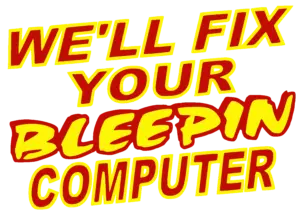I stayed at the shop quite a bit past closing last night to finish a customer’s laptop transition from an old 10 machine to a new 11 laptop. Like many, he had a Windows 10 computer that was no way near compatible with Windows 11. His old machine didn’t meet the processor or TPM security chipset requirements. Bypassing the requirements using the official Microsoft registry hack would have left him with a ridiculously slow computer.
When he originally came in I suggested he purchase a new computer or laptop and have me make the new one a mirror image of the old. Of course the new one would be upgraded to Windows 11, but the software, settings and data set would be identical. This minimizes the frustration of transitioning from the old to the new.
As I was working I started thinking about the transitions my little company used to make. Back when Windows 98 was no longer supported customers brought in Windows XP computers. We had the hurtle of duplicating from a DOS based system to NTFS while maintaining all the programs and data. It was a task but my team managed to do it.
In those days duplicating drives was a chore because it was a relatively new thing. Most techs were doing a clean install and migrating data. Big companies were using a product called Norton Ghost. My little company used command line tools in DOS. Cloning a drive took hours and frequently ended in failure which required multiple retries.
When Vista came onto the scene customers purchased new machines, used them and became frustrated with all the security settings from Windows Security Center and User Account Control. Thinking back, they were annoying. Anyways, XP was the only viable replacement for Vista so we became masters of downgrading computers. Vista hardware wasn’t designed for XP and an install off the retail CD failed almost 100% of the time. We burned a lot of custom XP install disks modified for each machine that came through the door.
Prior to solid state drives I used to advertise RAID as a way of increasing the speed of XP. Basically, the RAID we were using spread the data over several drives making the read speed twice as fast. The problems happened when customers wanted to migrate to a computer with a single drive. We came up with an elegant solution that essentially erased the drive loader after the clone and replaced it with a custom version I created.
Windows 7 and 8 were pretty straight forward upgrades. By this time I invested in Norton Ghost which is more or less a one-click duplicating utility. Hard drive technology changed from the very slow and clunky IDE interface to SATA which was 2-4X faster. We could clone a drive in a matter of hours. I made the decision that every hard drive that needed major work would be backed up using Ghost and stored on our secure server for a few weeks after the customer picked up their computer.
My goal was to eliminate the chances of losing customer data. There were many failures upgrading from Vista to both 7 and 8. Most of the time customers wouldn’t notice them until they used the machine for a couple days, Because we maintained a backup of their drive they could return within a couple weeks and we could redo the process. It was soul crushing when a computer came back 2 to 3 times for the same repair but it was part of the process.
Fast forward to 2025 and don’t figure I find myself using DOS commands to upgrade from Windows 10 to 11. It would be fairly straight forward if the source and target were the same or similar hardware. Pretty much anyone can do that. Last night’s machine was an 8 year old 7th generation Intel and the target was a 13th generation. Two totally different platforms.
After taking a break I came back to the new laptop with an entirely different approach to putting a clone of Windows 10 on a native Windows 11 laptop. I went back to 1990 when my buddies and I would modify software and create our own workarounds. Back when there were no graphical interfaces like Windows and we only had DOS command line to work with.
It all came down to executing 1990s code on a black and white screen that made a 2015 operating system spring to life on a 2025 computer like it was there the whole time.
Another fine article written by Jeromy Patriquin. For more you can visit LocalComputerWiz.com. Thanks for reading and I hope you enjoy my other articles.


